
Expo 2008
Encyclopedia

Zaragoza
Zaragoza , also called Saragossa in English, is the capital city of the Zaragoza Province and of the autonomous community of Aragon, Spain...
, Spain
Spain
Spain , officially the Kingdom of Spain languages]] under the European Charter for Regional or Minority Languages. In each of these, Spain's official name is as follows:;;;;;;), is a country and member state of the European Union located in southwestern Europe on the Iberian Peninsula...
, with the theme of "Water and Sustainable Development". The exposition was placed in a meander
Meander
A meander in general is a bend in a sinuous watercourse. A meander is formed when the moving water in a stream erodes the outer banks and widens its valley. A stream of any volume may assume a meandering course, alternately eroding sediments from the outside of a bend and depositing them on the...
of the river
River
A river is a natural watercourse, usually freshwater, flowing towards an ocean, a lake, a sea, or another river. In a few cases, a river simply flows into the ground or dries up completely before reaching another body of water. Small rivers may also be called by several other names, including...
Ebro
Ebro
The Ebro or Ebre is one of the most important rivers in the Iberian Peninsula. It is the biggest river by discharge volume in Spain.The Ebro flows through the following cities:*Reinosa in Cantabria.*Miranda de Ebro in Castile and León....
. It was coordinated by the Bureau of International Expositions
Bureau of International Expositions
The International Exhibitions Bureau is an intergovernmental organization created to supervise international exhibitions falling under the jurisdiction of the Convention Relating to International Exhibitions....
, the organization responsible for sanctioning World's Fair
World's Fair
World's fair, World fair, Universal Exposition, and World Expo are various large public exhibitions held in different parts of the world. The first Expo was held in The Crystal Palace in Hyde Park, London, United Kingdom, in 1851, under the title "Great Exhibition of the Works of Industry of All...
s.
Zaragoza, host city for the International Exposition, is the administrative and financial capital of the autonomous community
Autonomous communities of Spain
An autonomous community In other languages of Spain:*Catalan/Valencian .*Galician .*Basque . The second article of the constitution recognizes the rights of "nationalities and regions" to self-government and declares the "indissoluble unity of the Spanish nation".Political power in Spain is...
of Aragon
Aragon
Aragon is a modern autonomous community in Spain, coextensive with the medieval Kingdom of Aragon. Located in northeastern Spain, the Aragonese autonomous community comprises three provinces : Huesca, Zaragoza, and Teruel. Its capital is Zaragoza...
and Spain's fifth most populous city. Zaragoza was elected the host city of Expo 2008 on December 16, 2004 by the BIE
Bureau of International Expositions
The International Exhibitions Bureau is an intergovernmental organization created to supervise international exhibitions falling under the jurisdiction of the Convention Relating to International Exhibitions....
, beating Thessaloniki
Thessaloniki
Thessaloniki , historically also known as Thessalonica, Salonika or Salonica, is the second-largest city in Greece and the capital of the region of Central Macedonia as well as the capital of the Decentralized Administration of Macedonia and Thrace...
(Greece
Greece
Greece , officially the Hellenic Republic , and historically Hellas or the Republic of Greece in English, is a country in southeastern Europe....
) and Trieste
Trieste
Trieste is a city and seaport in northeastern Italy. It is situated towards the end of a narrow strip of land lying between the Adriatic Sea and Italy's border with Slovenia, which lies almost immediately south and east of the city...
(Italy
Italy
Italy , officially the Italian Republic languages]] under the European Charter for Regional or Minority Languages. In each of these, Italy's official name is as follows:;;;;;;;;), is a unitary parliamentary republic in South-Central Europe. To the north it borders France, Switzerland, Austria and...
).
The exhibition’s most emblematic buildings were the Water Tower
Water Tower (Zaragoza)
The Water Tower is a 76-metre-high tower built at the Expo 2008 site in Zaragoza, Spain. It was designed by Enrique de Teresa and constructed of concrete, steel and glass....
, a 80-metre-high transparent building designed by Enrique de Teresa to evoke a drop of water, Zaha Hadid
Zaha Hadid
Zaha Hadid, CBE is an Iraqi-British architect.-Life and career:Hadid was born in 1950 in Baghdad, Iraq. She received a degree in mathematics from the American University of Beirut before moving to study at the Architectural Association School of Architecture in London.After graduating she worked...
's Bridge Pavilion
Bridge Pavilion
The Bridge Pavilion is a building designed by British-Iraqi architect Zaha Hadid that was constructed for the Expo 2008 in Zaragoza as one of its main landmarks. It is an innovative 270-metre-long covered bridge that imitates a gladiola over the river Ebro, connecting the neighbourhood of La...
, and the river aquarium. The exposition site also hosted several events, including a daily parade by Cirque du Soleil
Cirque du Soleil
Cirque du Soleil , is a Canadian entertainment company, self-described as a "dramatic mix of circus arts and street entertainment." Based in Montreal, Quebec, Canada, and located in the inner-city area of Saint-Michel, it was founded in Baie-Saint-Paul in 1984 by two former street performers, Guy...
called The Awakening of the Serpent.
Aside from the countries, non-government organizations and private companies took part in Expo 2008, always with the idea of water and sustainable development. Prior to the event, the Expo 2008 host committee estimated that the expo event could generate 135 million euro
Euro
The euro is the official currency of the eurozone: 17 of the 27 member states of the European Union. It is also the currency used by the Institutions of the European Union. The eurozone consists of Austria, Belgium, Cyprus, Estonia, Finland, France, Germany, Greece, Ireland, Italy, Luxembourg,...
s in receipts for admission to the exhibition centre.
Bridge Pavilion
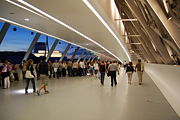
Bridge Pavilion
The Bridge Pavilion is a building designed by British-Iraqi architect Zaha Hadid that was constructed for the Expo 2008 in Zaragoza as one of its main landmarks. It is an innovative 270-metre-long covered bridge that imitates a gladiola over the river Ebro, connecting the neighbourhood of La...
was one of the most emblematic buildings of Expo 2008. Designed by Zaha Hadid
Zaha Hadid
Zaha Hadid, CBE is an Iraqi-British architect.-Life and career:Hadid was born in 1950 in Baghdad, Iraq. She received a degree in mathematics from the American University of Beirut before moving to study at the Architectural Association School of Architecture in London.After graduating she worked...
, it was built in two levels with the shape of a gladiolus
Gladiolus
Gladiolus is a genus of perennial bulbous flowering plants in the iris family...
opening and closing. It joins the neighbourhood of La Almozara and the Expo site with a central island in the river Ebro
Ebro
The Ebro or Ebre is one of the most important rivers in the Iberian Peninsula. It is the biggest river by discharge volume in Spain.The Ebro flows through the following cities:*Reinosa in Cantabria.*Miranda de Ebro in Castile and León....
.
The Bridge Pavilion hosted the exposition Water - a unique resource, designed by Ralph Appelbaum Associates, which tried to present water as a universal human right, to inform visitors how water is a unique resource and to explain water management procedures and encourage citizen participation.
Water Tower
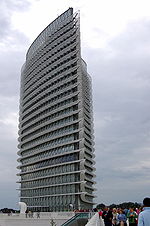
Water Tower (Zaragoza)
The Water Tower is a 76-metre-high tower built at the Expo 2008 site in Zaragoza, Spain. It was designed by Enrique de Teresa and constructed of concrete, steel and glass....
was another emblematic building of Expo 2008 and its vertical icon. Designed by Enrique de Teresa, it is 76 metres high with 10,400 accessible square metres. On the top floor, there is a 720-square-metre panoramic bar with fantastic views over Zaragoza
Zaragoza
Zaragoza , also called Saragossa in English, is the capital city of the Zaragoza Province and of the autonomous community of Aragon, Spain...
. Inside the tower there is a 23-metre-high sculpture called Splash, which represents a splash of water, "the arrival of life on our planet". The Splash sculpture, based on dynamic simulation systems, was designed by Mona Kim
Mona Kim
Mona Kim is a Korean-American designer born in South Korea and educated in the United States. Kim is a multidisciplinary design consultant and a visual artist for cultural and commercial projects ....
, Todd Palmer, Olga Subirós and Simon Taylor from Program Collective.
The Water Tower hosted the exposition Water for life where "audiovisual media and lighting play a key role in the way the contents are communicated".
Aquarium

Freshwater aquarium
A freshwater aquarium is a receptacle that holds one or more freshwater aquatic organisms for decorative, pet-keeping, or research purposes. Modern aquariums are most often made from transparent glass or acrylic glass. Typical inhabitants include fish, plants, amphibians, and invertebrates, such as...
in Europe, with 300 species of fauna from rivers around the world in 60 tanks or terrariums. Rivers represented are:
- The NileNileThe Nile is a major north-flowing river in North Africa, generally regarded as the longest river in the world. It is long. It runs through the ten countries of Sudan, South Sudan, Burundi, Rwanda, Democratic Republic of the Congo, Tanzania, Kenya, Ethiopia, Uganda and Egypt.The Nile has two major...
: It contains species of the great African lakes. It also has crocodileCrocodileA crocodile is any species belonging to the family Crocodylidae . The term can also be used more loosely to include all extant members of the order Crocodilia: i.e...
s and an exhibition on the Mediterranean and the Red SeaRed SeaThe Red Sea is a seawater inlet of the Indian Ocean, lying between Africa and Asia. The connection to the ocean is in the south through the Bab el Mandeb strait and the Gulf of Aden. In the north, there is the Sinai Peninsula, the Gulf of Aqaba, and the Gulf of Suez...
. - The MekongMekongThe Mekong is a river that runs through China, Burma, Laos, Thailand, Cambodia and Vietnam. It is the world's 10th-longest river and the 7th-longest in Asia. Its estimated length is , and it drains an area of , discharging of water annually....
: In this river visitors will find species of the HimalayasHimalayasThe Himalaya Range or Himalaya Mountains Sanskrit: Devanagari: हिमालय, literally "abode of snow"), usually called the Himalayas or Himalaya for short, is a mountain range in Asia, separating the Indian subcontinent from the Tibetan Plateau...
, gardens from the river's lower course, the Pacific OceanPacific OceanThe Pacific Ocean is the largest of the Earth's oceanic divisions. It extends from the Arctic in the north to the Southern Ocean in the south, bounded by Asia and Australia in the west, and the Americas in the east.At 165.2 million square kilometres in area, this largest division of the World...
and coral reefCoral reefCoral reefs are underwater structures made from calcium carbonate secreted by corals. Coral reefs are colonies of tiny living animals found in marine waters that contain few nutrients. Most coral reefs are built from stony corals, which in turn consist of polyps that cluster in groups. The polyps...
s. - The Amazon riverAmazon RiverThe Amazon of South America is the second longest river in the world and by far the largest by waterflow with an average discharge greater than the next seven largest rivers combined...
: It is divided into three different areas. The first of them is the Amazon jungle with its coconut trees and mangroveMangroveMangroves are various kinds of trees up to medium height and shrubs that grow in saline coastal sediment habitats in the tropics and subtropics – mainly between latitudes N and S...
s. The second area is about the Amazon forest while the third area is the mangrove swamp with an exhibition on the Atlantic OceanAtlantic OceanThe Atlantic Ocean is the second-largest of the world's oceanic divisions. With a total area of about , it covers approximately 20% of the Earth's surface and about 26% of its water surface area...
. - The Murray-Darling river: This exhibition begins in the flooded regions and goes through desert areas. It finishes with a video exhibition about birds.
- The EbroEbroThe Ebro or Ebre is one of the most important rivers in the Iberian Peninsula. It is the biggest river by discharge volume in Spain.The Ebro flows through the following cities:*Reinosa in Cantabria.*Miranda de Ebro in Castile and León....
: It is also represented in two areas. The first area is a mountain cave and the second is the course of the river. There will also be an exhibition on the Mediterranean seaMediterranean SeaThe Mediterranean Sea is a sea connected to the Atlantic Ocean surrounded by the Mediterranean region and almost completely enclosed by land: on the north by Anatolia and Europe, on the south by North Africa, and on the east by the Levant...
. - The "World River": It represents the past, when "all the continents were united as a single island surrounded by ocean".
Thirst
.jpg)
Igloo of Salt
Designed by Cloud 9 / Enric Ruiz-Geli, this plaza's architecture was that of an enigmatic building. It was an inflatable structure covered with salt that reflected the sun's rays and lit up at night as if it had stored all of the necessary energy to continue to function.This themed plaza was designed according to Expo Zaragoza 2008's sustainability criteria: the use of PVC
PVC
Polyvinyl chloride is a plastic.PVC may also refer to:*Param Vir Chakra, India's highest military honor*Peripheral venous catheter, a small, flexible tube placed into a peripheral vein in order to administer medication or fluids...
was avoided in electrical wiring, as well as tropical wood, synthetic varnish or solvent-based paints; taps made use of water-saving systems. Additionally, the frame was hired out to avoid having to demolish
Demolition
Demolition is the tearing-down of buildings and other structures, the opposite of construction. Demolition contrasts with deconstruction, which involves taking a building apart while carefully preserving valuable elements for re-use....
it once the expo was complete.
The use of EFTE in the building's three-layered roof made air conditioning unnecessary. One of the EFTE layers was silver-plated to refract light
Refraction
Refraction is the change in direction of a wave due to a change in its speed. It is essentially a surface phenomenon . The phenomenon is mainly in governance to the law of conservation of energy. The proper explanation would be that due to change of medium, the phase velocity of the wave is changed...
and prevent outside heat from penetrating the building; air in the inflatable components and a brine system
Brine
Brine is water, saturated or nearly saturated with salt .Brine is used to preserve vegetables, fruit, fish, and meat, in a process known as brining . Brine is also commonly used to age Halloumi and Feta cheeses, or for pickling foodstuffs, as a means of preserving them...
irrigating them cooled the interior. All of this created a temperate building, meaning that the climate control system
HVAC
HVAC refers to technology of indoor or automotive environmental comfort. HVAC system design is a major subdiscipline of mechanical engineering, based on the principles of thermodynamics, fluid mechanics, and heat transfer...
only needed to work against body heat
Thermoregulation
Thermoregulation is the ability of an organism to keep its body temperature within certain boundaries, even when the surrounding temperature is very different...
produced by visitors and heat given off by equipment used in the exhibition. This way the organisers could make use of a system that was much more sustainable and inexpensive than conventional air conditioning
HVAC
HVAC refers to technology of indoor or automotive environmental comfort. HVAC system design is a major subdiscipline of mechanical engineering, based on the principles of thermodynamics, fluid mechanics, and heat transfer...
.
Cities of water
This square had no walls, so its contents were visible from outside. The exhibit was about water as an "urban resource" and a "natural element in the process of improving quality of life in cities".Extreme water
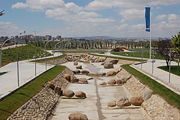
Shared water
This thematic square showed visitors how political divisions affect the management of water.Aquatic inspirations
This square hosted the show El hombre vertiente, created by the Argentine Pichón Baldinu, six times a day.Country pavilions
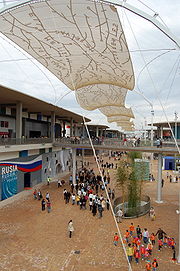
The 17 autonomous communities of Spain
Autonomous communities of Spain
An autonomous community In other languages of Spain:*Catalan/Valencian .*Galician .*Basque . The second article of the constitution recognizes the rights of "nationalities and regions" to self-government and declares the "indissoluble unity of the Spanish nation".Political power in Spain is...
and two autonomous cities of Ceuta
Ceuta
Ceuta is an autonomous city of Spain and an exclave located on the north coast of North Africa surrounded by Morocco. Separated from the Iberian peninsula by the Strait of Gibraltar, Ceuta lies on the border of the Mediterranean Sea and the Atlantic Ocean. Ceuta along with the other Spanish...
and Melilla
Melilla
Melilla is a autonomous city of Spain and an exclave on the north coast of Morocco. Melilla, along with the Spanish exclave Ceuta, is one of the two Spanish territories located in mainland Africa...
also participated, as did as the United Nations
United Nations
The United Nations is an international organization whose stated aims are facilitating cooperation in international law, international security, economic development, social progress, human rights, and achievement of world peace...
and the European Union
European Union
The European Union is an economic and political union of 27 independent member states which are located primarily in Europe. The EU traces its origins from the European Coal and Steel Community and the European Economic Community , formed by six countries in 1958...
.
The pavilions for official participants were divided into eight large buildings and into five differentiated eco-geographical areas within the Expo 2008 Exposition site. Those areas were:
- Islands and Coasts
- Oasis
- Ice and snow
- Temperate Forests
- Tropical Rainforests
- Mountains and High Plains
- Grasslands, Steppes and Savannahs
- Rivers and Flat plains
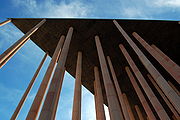
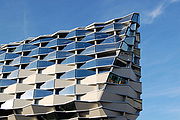
Sub-Saharan Africa
Sub-Saharan Africa as a geographical term refers to the area of the African continent which lies south of the Sahara. A political definition of Sub-Saharan Africa, instead, covers all African countries which are fully or partially located south of the Sahara...
, Latin America
Latin America
Latin America is a region of the Americas where Romance languages – particularly Spanish and Portuguese, and variably French – are primarily spoken. Latin America has an area of approximately 21,069,500 km² , almost 3.9% of the Earth's surface or 14.1% of its land surface area...
and the Caribbean Community (CARICOM), respectively. The total surface area of the participating countries pavilions was 61,667 m².
Spain
Spain
Spain , officially the Kingdom of Spain languages]] under the European Charter for Regional or Minority Languages. In each of these, Spain's official name is as follows:;;;;;;), is a country and member state of the European Union located in southwestern Europe on the Iberian Peninsula...
and the region of Aragon
Aragon
Aragon is a modern autonomous community in Spain, coextensive with the medieval Kingdom of Aragon. Located in northeastern Spain, the Aragonese autonomous community comprises three provinces : Huesca, Zaragoza, and Teruel. Its capital is Zaragoza...
, as hosts, had their own separate pavilions. The Spain Pavilion was designed by Patxi Mangado, and the Aragon Pavilion, which resembled local basketweaving, by Daniel Olano.
Citizen's initiative pavilion
This pavilion had the shape of a beacon, "a symbol of hope for the future of water in our world". It expressed the vitality of ordinary people and non-governmental organisations.The Beacon was situated by the Bridge Pavilion entrance.
Gold Prize award
The PhilippinesPhilippines
The Philippines , officially known as the Republic of the Philippines , is a country in Southeast Asia in the western Pacific Ocean. To its north across the Luzon Strait lies Taiwan. West across the South China Sea sits Vietnam...
, on September 19, 2008 won the "Gold Prize", the Expo's highest award for a participating country. The award noted the quality of the Philippine pavilion’s internal and external décor, consisting of 1,000 crystal-like bubble sand, as well as its functionality, which had supreme relevance to the exposition’s theme of “Water and Sustainable Development.” Tourism Secretary Joseph Ace Durano
Joseph Ace Durano
Joseph Hotchkiss Durano , popularly known as Ace Durano, was one of the youngest to be elected representative to the 11th congress...
said “this recognition is truly well-deserved as our country’s wealthy aquatic life has been captured by the equally rich imagination of our fellowmen. While other countries utilized ultra modern technology, we chose to highlight more community-involved practices as well as natural land irrigation, aquatic recreation and marine resources preservation.” The Philippine pavilion's attractions included the meeting of the two mascots, Fluvi and Filippo, and “Filipinas Te Espera Nights,” a series of marketing events.
Shows
Expo 2008 had a 93-day-long show programme with more than 3,400 acts from more than 350 companies and artists.On the expo site, there were three shows called major events. They were:
Iceberg
This show was intended to be the artistic part of the Opening Ceremony, although the flood of the river Ebro in the previous days forced plans to change, as the set was situated in the middle of the river. Nevertheless, the show was presented each night starting on 20 June. The Spanish director Calixto BieitoCalixto Bieito
Calixto Bieito is a Spanish theater director known for his "radical" interpretations of classic operas.-Biography:...
and the scenographer Alfons Flores were responsible for the set design while the music was by José Luis Romeo. The show had a huge iceberg with a minute human figure designed by the Catalan
Catalonia
Catalonia is an autonomous community in northeastern Spain, with the official status of a "nationality" of Spain. Catalonia comprises four provinces: Barcelona, Girona, Lleida, and Tarragona. Its capital and largest city is Barcelona. Catalonia covers an area of 32,114 km² and has an...
company FOCUS.
El hombre vertiente
This show, created by the Argentine Pichón Baldinu, was the artistic part of the Opening Ceremony on 13 June 2008, in replacement of "Iceberg". It repeated six times throughout the day at the thematic square Water Inspirations.The Awakening of the Serpent
This water-themed parade took place every day at the Expo site as "The Awakening of the Serpent" wandered around the site. The parade's creative director was Jean François Brouchard and its artistic director Julien Gabriel. Canada's Cirque du SoleilCirque du Soleil
Cirque du Soleil , is a Canadian entertainment company, self-described as a "dramatic mix of circus arts and street entertainment." Based in Montreal, Quebec, Canada, and located in the inner-city area of Saint-Michel, it was founded in Baie-Saint-Paul in 1984 by two former street performers, Guy...
participated with acrobats
Acrobatics
Acrobatics is the performance of extraordinary feats of balance, agility and motor coordination. It can be found in many of the performing arts, as well as many sports...
, actor
Actor
An actor is a person who acts in a dramatic production and who works in film, television, theatre, or radio in that capacity...
s, gymnast
Gymnast
Gymnasts are people who participate in the sports of either artistic gymnastics, trampolining, or rhythmic gymnastics.See gymnasium for the origin of the word gymnast from gymnastikos.-Female artistic:Australia...
s, singers and musician
Musician
A musician is an artist who plays a musical instrument. It may or may not be the person's profession. Musicians can be classified by their roles in performing music and writing music.Also....* A person who makes music a profession....
s.
Bob Dylan & additional American artists
Expo 2008 officially opened with a concert by Bob DylanBob Dylan
Bob Dylan is an American singer-songwriter, musician, poet, film director and painter. He has been a major and profoundly influential figure in popular music and culture for five decades. Much of his most celebrated work dates from the 1960s when he was an informal chronicler and a seemingly...
, the Official Artist of Expo 2008.
Additional American artists scheduled to perform on the evening entertainment stage included Patti Smith
Patti Smith
Patricia Lee "Patti" Smith is an American singer-songwriter, poet and visual artist, who became a highly influential component of the New York City punk rock movement with her 1975 debut album Horses....
, Robert Cray
Robert Cray
Robert Cray is an American blues guitarist and singer. A five-time Grammy Award winner, he has led his own band, as well as an acclaimed solo career.-Career:...
, Keb Mo, Ruben Blades
Rubén Blades
Rubén Blades Bellido de Luna is a Panamanian salsa singer, songwriter, lawyer, actor, Latin jazz musician, and politician, performing musically most often in the Afro-Cuban and Latin jazz genres...
, Canadian Diana Krall
Diana Krall
Diana Jean Krall, OC, OBC is a Canadian jazz pianist and singer, known for her contralto vocals. She has sold more than 6 million albums in the US and over 15 million worldwide; altogether, she has sold more albums than any other female jazz artist during the 1990s and 2000s...
, The Stray Cats, Los Lobos
Los Lobos
Los Lobos are a multiple Grammy Award–winning American Chicano rock band from East Los Angeles, California. Their music is influenced by rock and roll, Tex-Mex, country, folk, R&B, blues, brown-eyed soul, and traditional Spanish and Mexican music such as cumbia, boleros and norteños.-History:The...
and Gloria Estefan
Gloria Estefan
Gloria María Milagrosa Fajardo García de Estefan; known professionally as Gloria Estefan is a Cuban-born American singer, songwriter, and actress. Known as the "Queen Of Latin Pop", she is in the top 100 best selling music artists with over 100 million albums sold worldwide, 31.5 million of those...
. A performance by Philip Glass
Philip Glass
Philip Glass is an American composer. He is considered to be one of the most influential composers of the late 20th century and is widely acknowledged as a composer who has brought art music to the public .His music is often described as minimalist, along with...
closed Expo 2008.
Mascot
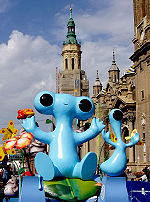
With his best friend Ica, the smallest drop of water, and Nico and Laurita, he fought against the pollution made by Sec and Raspa, the evil Negas.
Qatar
Qatar
Qatar , also known as the State of Qatar or locally Dawlat Qaṭar, is a sovereign Arab state, located in the Middle East, occupying the small Qatar Peninsula on the northeasterly coast of the much larger Arabian Peninsula. Its sole land border is with Saudi Arabia to the south, with the rest of its...
issused a postage stamp
Postage stamp
A postage stamp is a small piece of paper that is purchased and displayed on an item of mail as evidence of payment of postage. Typically, stamps are made from special paper, with a national designation and denomination on the face, and a gum adhesive on the reverse side...
miniature sheet
Miniature sheet
A souvenir sheet or miniature sheet is a small group of postage stamps still attached to the sheet on which they were printed. They may be either regular issues that just happen to be printed in small groups , or special issues often commemorating some event, such as a national anniversary,...
commemorating Expo Zaragoza 2008, which pictured Fluvi.
After the Expo
The exposition site and its facilities were planned thinking of their usage as a new extension of the city when the Expo finished in September 2008. The expectation was that some the buildings would be rented or transferred to several institutions. The Aragon Pavilion was to be converted into the head office of a regional ministry, while the landmark buildings of the Expo, the Water TowerWater Tower (Zaragoza)
The Water Tower is a 76-metre-high tower built at the Expo 2008 site in Zaragoza, Spain. It was designed by Enrique de Teresa and constructed of concrete, steel and glass....
and the Bridge Pavilion
Bridge Pavilion
The Bridge Pavilion is a building designed by British-Iraqi architect Zaha Hadid that was constructed for the Expo 2008 in Zaragoza as one of its main landmarks. It is an innovative 270-metre-long covered bridge that imitates a gladiola over the river Ebro, connecting the neighbourhood of La...
, were expected to be purchased by local financial institutions. The Spanish Pavilion were expected to be used by the University of Zaragoza
University of Zaragoza
The University of Zaragoza or sometimes Saragossa University is a university located in Zaragoza, in the Aragon region of Spain...
to set up a new school of architecture.
The international pavilions were to be remodelled and converted into offices so that the site would become the main business park
Business park
A business park or office park is an area of land in which many office buildings are grouped together. All of the work that goes on is commercial, not industrial or residential....
in Zaragoza
Zaragoza
Zaragoza , also called Saragossa in English, is the capital city of the Zaragoza Province and of the autonomous community of Aragon, Spain...
. This space was also to have recreational establishments and restaurants.
Other expectations were that a great part of the site would be used for shopping establishments and for the construction of a science park
Science park
A research park, science park, or science and technology park is an area with a collection of buildings dedicated to scientific research on a business footing. There are many approximate synonyms for "science park", including research park, technology park, technopolis and biomedical park...
for businesses.
The Aquarium, as the largest freshwater aquarium in Europe
Europe
Europe is, by convention, one of the world's seven continents. Comprising the westernmost peninsula of Eurasia, Europe is generally 'divided' from Asia to its east by the watershed divides of the Ural and Caucasus Mountains, the Ural River, the Caspian and Black Seas, and the waterways connecting...
, was expected to remain open for at least eleven years.
External links
- Official Expo 2008
- Bureau of International Expositions
- ExpoMuseum's Expo 2008 Page
- Polish Pavilion
- French Pavilion
- German Pavilion
- Danish Pavilion
- Japanese Pavilion
- Italian Pavilion
- Portuguese Pavilion
- Galician Pavilion
- Expo Zaragoza 2008 Emblematic Buildings & Pavilions from Aragon Guide .com
- Basic and Practice Information about Expo 2008
- Beacon official website
- The 21 metre tall Splash sculpture.
- An upgraded video-serie about the Expo2008









































































































